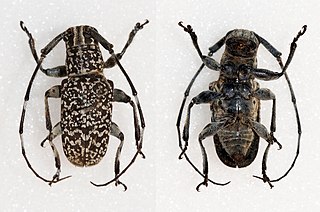
Cacia is a genus of longhorn beetles of the subfamily Lamiinae.
Cacia elegans is a species of longhorn beetles of the subfamily Lamiinae.
Cacia subcephalotes is a species of beetle in the family Cerambycidae. It was described by Stephan von Breuning in 1968. It is known from Laos.
Cacia albovariegata is a species of beetle in the family Cerambycidae. It was described by Stephan von Breuning in 1935. It is known from Cambodia.
Cacia curta is a species of beetle in the family Cerambycidae. It was described by Stephan von Breuning in 1935. It is known from Java.
Cacia celebensis is a species of beetle in the family Cerambycidae. It was described by Stephan von Breuning in 1938. It is known from Sulawesi.
Cacia kaszabi is a species of beetle in the family Cerambycidae. It was described by Stephan von Breuning in 1954. It is known from Sulawesi.
Cacia kinabaluensis is a species of beetle in the family Cerambycidae. It was described by Stephan von Breuning in 1982. It is known from Borneo.
Cacia palawanica is a species of beetle in the family Cerambycidae. It was described by Stephan von Breuning in 1936. It is known from the Philippines.
Cacia albofasciata is a species of beetle in the family Cerambycidae. It was described by Stephan von Breuning in 1980. It is known from the Philippines.
Cacia albocancellata is a species of beetle in the family Cerambycidae. It was described by Stephan von Breuning in 1974. It is known from the Philippines.
Cacia basialboantennalis is a species of beetle in the family Cerambycidae. It was described by Stephan von Breuning in 1958. It is known from Bhutan.
Cacia flavipennis is a species of beetle in the family Cerambycidae. It was described by Stephan von Breuning in 1947. It is known from the Philippines.
Cacia transversefasciata is a species of beetle in the family Cerambycidae. It was described by Stephan von Breuning in 1947. It is known from the Philippines.
Cacia suturevitta is a species of beetle in the family Cerambycidae. It was described by Stephan von Breuning in 1963. It is known from Laos.
Cacia coomani is a species of beetle in the family Cerambycidae. It was described by Stephan von Breuning in 1958. It is known from Vietnam.
Cacia guttata is a species of beetle in the family Cerambycidae. It was described by Per Olof Christopher Aurivillius in 1927. It is known from Java and Moluccas.
Cacia inculta is a species of beetle in the family Cerambycidae. It was described by Francis Polkinghorne Pascoe in 1857.

Cacia vermiculata is a species of beetle in the family Cerambycidae. It was described by Heller in 1923. It is known from the Philippines.
Cacia semiluctuosa is a species of beetle in the family Cerambycidae. It was described by Émile Blanchard in 1853.


